Measuring in at 12.0” x 9.6”, MSI’s Z87-G43 Gaming conforms to the standard ATX form factor. Despite the board’s highly-attractive red and black colour scheme that is indicative of the company’s Gaming series components, MSI hampers the overall appearance by using an ugly brown PCB.
The brown PCB is by no means a deal-breaker, but it does have a somewhat negative effect on the board’s appearance in a well-lit system.
Up to 32GB of DDR3 memory can be installed in the all-black DIMM slots. MSI claims support for 3000MHz memory speeds, although the real-world maximum frequency will also be related to the strength of a CPU’s IMC.
An outwards-facing USB 3.0 header is located next to the 24-pin power connector. The outwards-facing orientation increases the complexity of hiding the chunky USB 3.0 cable, but it also enhances compatibility with narrow cases.
MSI uses a basic six phase power delivery system to feed an LGA 1150 CPU. In actual fact, the basic system should suffice for the low power Haswell chips which typically meet their thermal limit (for 24/7 usage) before voltages and currents become an issue.
The Z87-G43 Gaming doesn’t use MSI’s full complement of Military Class 4 power delivery components; the company deems Super Ferrite Chokes (SFC) and aluminium-core ‘Dark’ capacitors sufficient. uPI semiconductor's uP1649P acts as the voltage regulator.
A pair of red, dragon-shaped heatsinks cools the MOSFETs and enhances the board’s appearance.
Nestled between the pair of MOSFET heatsinks is an 8-pin CPU power connector. The connector’s positioning makes it easy to access for a cable routed behind a case’s motherboard tray, but its orientation which is flipped by 90 degrees makes physically attaching the power connector a little more difficult.
Two 4-pin fan headers are located within the vicinity of the CPU area. Both connections are linked to the CPU fan speed PWM control channel.
A pair of full-length PCI-E x16 slots is present on the Z87-G43 Gaming. But before you get excited, there are a number of caveats.
Firstly, the lower full-length slot only operates at PCI-E 2.0 x4 bandwidth. While the board technically supports CrossFire, a pair of high-end cards is likely to be crippled by the secondary slot’s reduced bandwidth.
Secondly, due to the reduced bandwidth secondary PCI-E x16 slot, SLI is not supported. SLI operation dictates a pair of x8 links, which this board cannot provide.
On the bright side, that chipset-linked x4 connection is useful for low bandwidth devices such as a PCI-E SSD (albeit an unlikely purchase to this board’s target audience I suppose Plextor has something to say about that affordability question mark) or a physics (or cryptocurrency mining, for that matter) card.
Three PCI and two PCI-E x1 slots indicate the Z87-G43 Gaming’s entry-level design. MSI’s slot spacing is good; a dual- or triple-slot graphics card can be used without interfering with the useful x16-length (x4 link) connection and one of the PCI-E x1 slots. PCI connectors are provided (by an ASMedia ASM1083 bridge) for legacy purposes and for keeping some users’ upgrades as low-cost as possible.
Headers are found in their typical locations along the motherboard’s bottom-edge – audio to the left and front panel connections to the right.
A pair of USB 2.0 headers is found in central locations, accompanied by a single 4-pin fan header.
One needless cost-cutting measure was MSI's decision to omit the on-PCB writing accompanying the front panel header block. This meant that we were forced to resort to the user manual when connecting front panel cables, rather than simply read the relevant connection information from writing on the PCB.
All six of the SATA 6Gb/s ports operate from the Z87 chipset. MSI orientates four in a right-angled configuration and two in an outwards-facing style. This design choice is likely to be related to increased compatibility with cramped cases.
We noticed that the two outwards-facing ports were blocked by our graphics card's triple-slot cooler. This causes problems for triple-slot graphics card users who want to connect a boot SSD, optical drive, and three storage drives, many of whom may well fall into the G43 Gaming's target audience.
MSI may have been wiser to shift the ports closer towards the bottom of the motherboard; the likelihood of a long graphics card being installed in the lower PCI-E slot is far lower.
With enhanced sound configurations becoming a trend with the introduction of Z87 motherboards, MSI equips the Z87-G43 Gaming with its own solution called Audio Boost.
Audio Boost consists of a Realtek ALC1150 audio codec which sends the raw signal through a Texas Instruments OPA1652 operational amplifier and a series of audio capacitors before outputting it to the audio jacks. The process takes place on an isolated circuit and outputs the signal to gold-plated audio jacks, with both measures helping to reduce signal interference.
Sound Blaster Cinema is also supported by the Z87-G43 Gaming.
The Z87-G43 Gaming's rear IO ports are representative of a value motherboard. Two USB 3.0 ports remaining from the chipset-provided quartet make an appearance below the Killer E2205-fed Gigabit Ethernet connection.
Some users may deem two USB 3.0 ports insufficient, but when coupled with the two connections from the internal header, four ports is likely to suffice for the Z87-G43 Gaming's target audience.
Gold-plated audio jacks reduce the amount of interference that is inserted into a sound output signal. The lack of an optical SPDIF jack will inconvenience users wanting the Z87-G43 Gaming to serve media purposes.
HDMI 1.4, single-link DVI-D, and VGA outputs allow up to three displays to be powered by a Haswell CPU installed in the Z87-G43 Gaming. The lack of DisplayPort means that there is no real way to get a high-frequency 2560 or above output from the onboard connections (HDMI forces a reduced refresh rate, if it can be made to run at a 2560 resolution at all).
Motherboard rear ports:
- 1 x PS/2 keyboard/mouse combo port
- 6 x USB 2.0 ports
- 2 x USB 3.0 ports
- 1 x RJ45 LAN jack
- 6 x OFC audio jacks
- 1 x VGA port
- 1 x DVI-D port
- 1 x HDMI port
The company’s eye-catching dragon heatsinks, which are unique to the Gaming series, are present on the Z87-G43 Gaming. While the heatsinks themselves provide the function of cooling components, the unique and innovative designs appeal to users who value the appearance of their system.
Circled in the above image are the locations of the Z87-G43 Gaming’s five 4-pin fan headers. Distribution of the fan headers is very good; two CPU headers are positioned around the LGA1150 socket, while the remaining three headers are placed in relevant locations.
Indicative of the Z87-G43 Gaming's low-cost-Z87 price bracket, MSI reserves the OC Genie function for a BIOS selection, rather than the typically-included onboard button.
 KitGuru KitGuru.net – Tech News | Hardware News | Hardware Reviews | IOS | Mobile | Gaming | Graphics Cards
KitGuru KitGuru.net – Tech News | Hardware News | Hardware Reviews | IOS | Mobile | Gaming | Graphics Cards


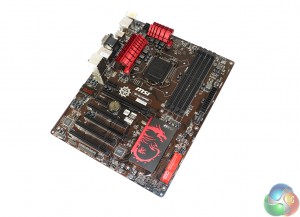
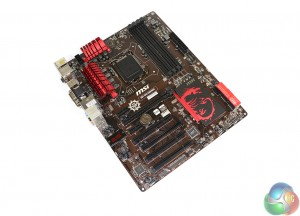
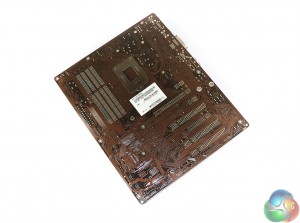
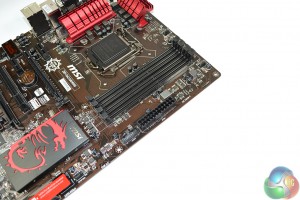
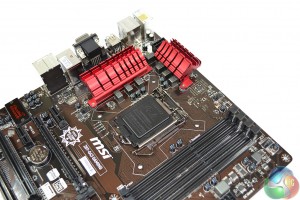
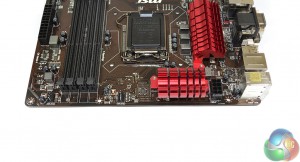
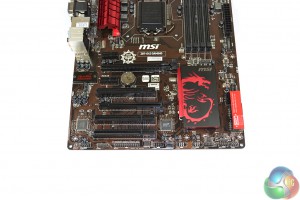
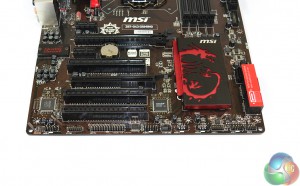
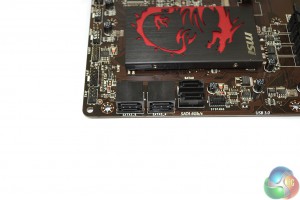
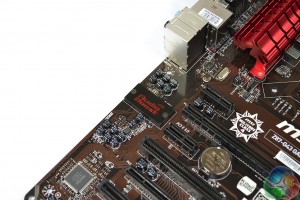
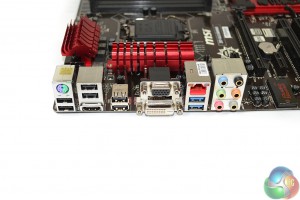
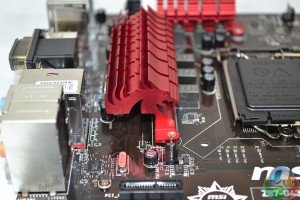
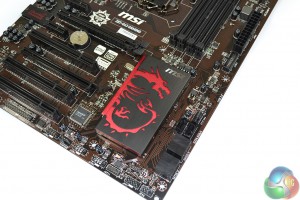
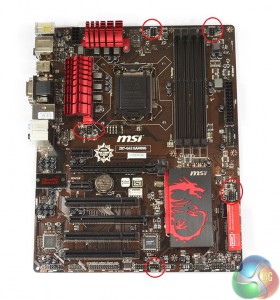

Thats one of the best value for money boards you can get, two of my friends have it, and it really is all you would ever need. Love it.
Have one already, fantastic board. I found though that some Corsair memory had boot problems with it if you populated all the slots…
I was about to purchase the G45 Gaming, but there was no stock in our local store by the time so I opted for this G43 Gaming. I’m so happy it did not let me down. I thought this is one of the best budget Z87 boards out there!
Is there a laptop version ?
abraham ortiz, this is a desktop motherboard. There is no laptop version.
“Built around MSI’s tried-and-tested Military Class 4 components” What a joke this is. First there is no ML STD anymore. It was replaced by IPC. Military falls under class 3 requirements. “Whereas Class 3 products demand continued high performance or performance-on-demand is critical and equipment downtime cannot be tolerated, the end use environment may be uncommonly harsh, and the equipment must function when required, such as life support or other critical systems” I am a certified IPC specialist, and can tell you that it does likely meet the class 3 military spec, BUT so does almost every other manufacturer.